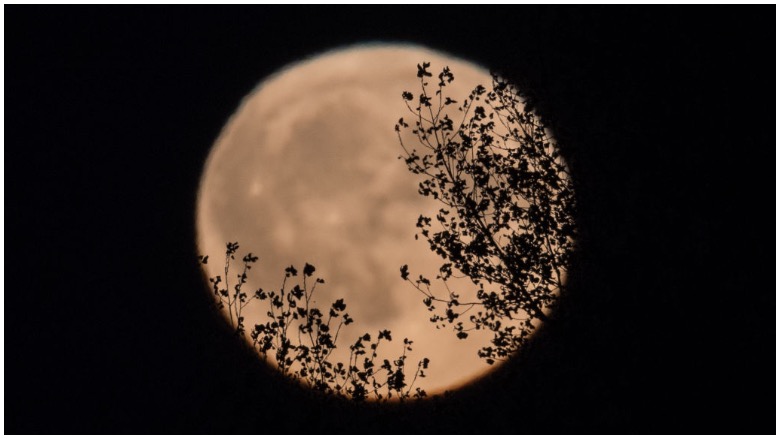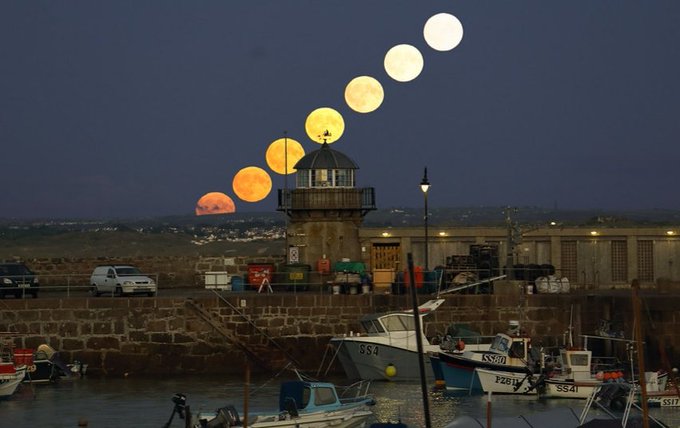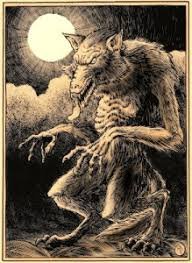
Getty A harvest moon.
A Harvest Moon, or the full moon that lands closest to the fall equinox, is due to appear in the sky on the night of Friday, September 13, 2019, according to NASA.
According to the Farmer’s Almanac, the Full Harvest Moon rises at sunset and then will rise very near sunset for several nights in a row because the difference is at a yearly minimum, making it seem as if there are full Moons multiple nights in a row. NASA says that the Moon will appear full for about three days centered around this time, from Thursday night through Sunday morning.
Here’s what you need to know:
1. The Harvest Moon Relates to the Timing of the Autumnal Equinox
According to the Farmer’s Almanac, the Harvest Moon differs from other full moons because it is not associated with a specific month, as the others are. Instead, the Harvest Moon relates to the timing of the autumnal equinox.
The word “equinox” comes from Latin aequus, meaning “equal,” and nox, “night.” On the equinox, day and night are roughly equal in terms of length, as defined by Merriam Webster.
The autumnal equinox, also called the September or fall equinox, which is the astronomical start of fall in the Northern Hemisphere and of spring in the Southern Hemisphere, usually occurs between September 22 and 23 each year. The full moon that occurs nearest to the autumnal equinox takes on the name “Harvest Moon.”
2. There is Bright Moonlight During the Early Evenings on Nights With a Harvest Moon
Astro photographer Shaun Reynolds captured the beautiful colors and movements of last year’s Harvest Moon during his time in St Ives, Cornwall, England in 2018.
According to NASA, the full Moon usually rises an average of 50 minutes later each night, but for the few nights around the Harvest Moon, the Moon seems to rise at nearly the same time: just 25 to 30 minutes later across the northern U.S., and only 10 to 20 minutes later for much of Canada and Europe.
Farmers have been known to work late into the night by the light of the Moon during the harvest season. For several evenings, the moonrise comes soon after sunset, which results in an abundance of bright moonlight early in the evening. According to the Farmer’s Almanac, the light has been a traditional aide to farmers and crews harvesting their summer-grown crops.
Because the Harvest Moon does not always appear in September, NASA says that there are several other names for it, including the Fruit Moon, the Barley Moon, the Corn Moon, the Mid-Autumn Festival Moon, the Chuseok Moon, the Modhu Purnima and the Binara Pura Pasalosvaka Poya.
3. This Year’s Harvest Moon Falls on Friday the 13th
“Dig out your lucky charms and hold on tight, folks – this could be one heck of a Friday!” Journalist Mark Rees wrote on Twitter.
According to NASA, this year’s Harvest Moon will be full early Saturday morning, September 14, 2019, appearing “opposite” the Sun at 12:33 AM EDT. The Moon will appear full for about three days centered around this time, from Thursday night through Sunday morning.
It is the most ominous date on the calendar and ome people are calling this Harvest Moon the “spookiest full moon.” The last time a full moon fell on Friday the 13th was on October 13th, 2000, according to the Farmer’s Almanac, and it will not happen again until August 13th, 2049.
The Farmer’s Almanac estimates that to have a full Moon occur on the 13th day of a particular month, and for that day to be a Friday, is an approximately once in 20-year occurrence.
4. This Year’s Harvest Moon is a ‘Mini’ or ‘Micro-Moon’
The harvest moon usually appears large and orange, however, in 2019 the Harvest Moon will seem unusually small. Friday’s Harvest Moon is a “micro full moon, according to Time and Date.
The site states that a micro moon happens when a full Moon or a New Moon coincides with apogee. for context, the point in the Moon’s orbit closest to Earth is called perigee, while the point in the orbit farthest from Earth is known as apogee. Because a micro moon is further away, it looks approximately 14% smaller than a Supermoon and a little less bright.
Old folklore accounts suggest that full moons and micro moons affect human mental health and bring on natural disasters, like earthquakes, but no scientific evidence supports any such correlation, according to Time and Date.
5. Some Believe the Harvest Moon Will Bring Increased Werewolf Activity
Compelled to leave their hunting grounds in the woods, they will make their way to open fields to prowl & howl at the moon,” Dr. Sam George wrote of werewolves during the Harvest Moon. “They may be found crossing roads & gardens.”
According to History, while then number 12 has always been associated with completeness, negative superstitions have been following the number 13 for centuries. There is even a psychological term for the fear of the number 13: triskaidekaphobia.
While some people might be afraid of Friday the 13th, others see it as a “special time.” Because Friday is associated with the goddess Venus, and there are 13 full moons and 13 menstrual cycles in one year, the full moon that falls on Friday the 13th is a powerful time, according to Refinery29.


